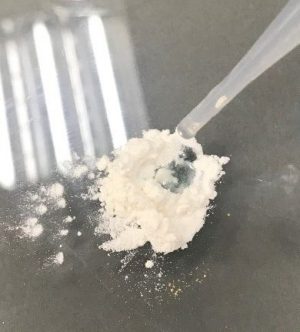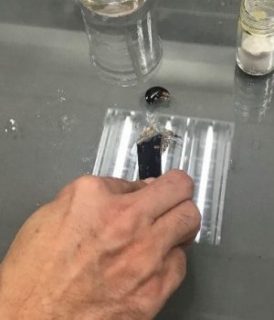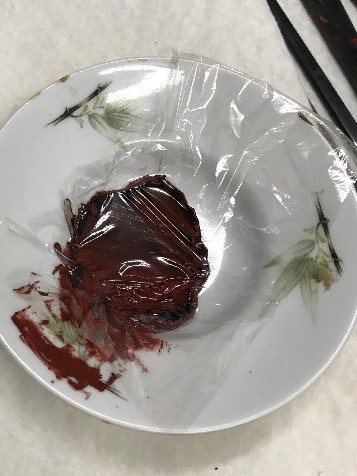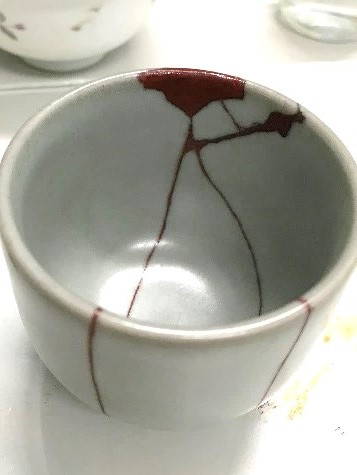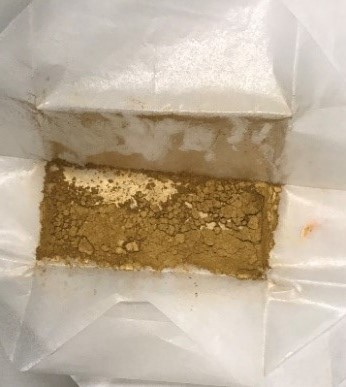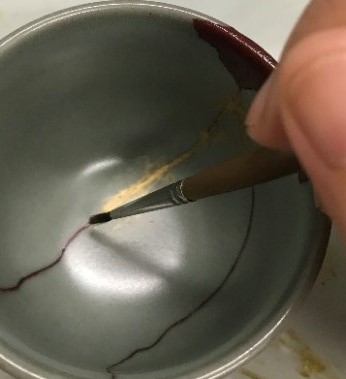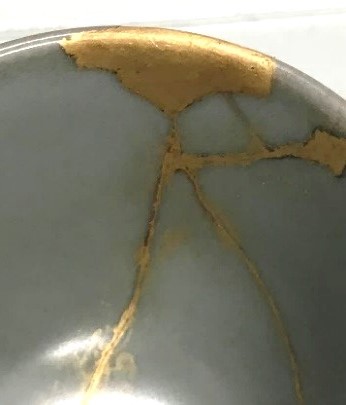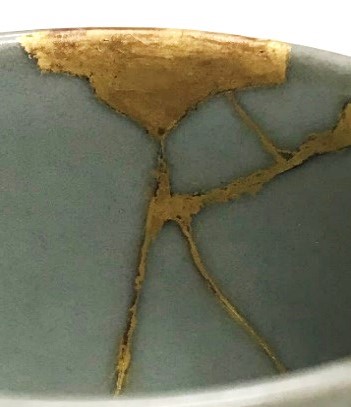Kintsugi: a Japanese traditional ceramic conservation skill
5 November 2019
Introduction
Kintsugi, also called Kintsukuroi, is a set of traditional Japanese ceramic repairing skills that has been practiced for centuries. Archaeologists and historians have found that some excavated pottery in Japan was repaired with lacquerware techniques around 1000 BCE. It is also believed that around the 15th century, Kinsukuroi was introduced from China. Kinsukuroi means “golden repair” and was originally not a repairing skill for ceramic vases. When the skill came to Japan, after some modification by combining the lacquerware decoration skills with repairing ceramic skills, it became Kintsugi, meaning “golden joinery”. Followed by the development of Chanoyu (Japanese tea ceremony) by the 17th century, Kintsugi became common practice in Japan.
There are many schools of Kintsugi nowadays, with each master or craftsman potentially having their own special detailed procedures and techniques but with the main process mainly conducted in the same sequence. The major steps are presented below.
Procedures
> Adhesion
Mix tonoko (a clay powder) with urushi (a kind of lacquer) until the necessary stickiness is achieved.
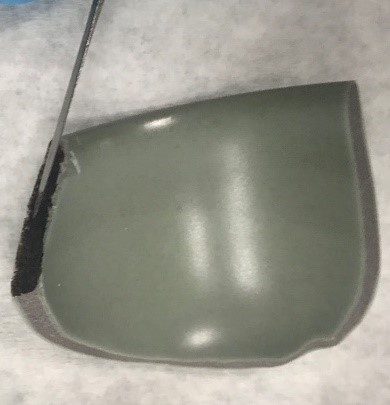
Apply a thin layer of the sticky clay onto broken edges and stick the pieces together.
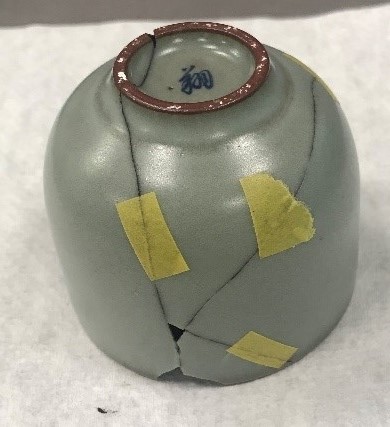
Sometimes other support may be needed to prevent the ceramic pieces from slipping before drying.
If there is any clay overflow from the edges, remove it with alcohol or it will be hard to clean after drying. In addition, the clay will only dry in higher relative humidity, near 70%, so if the relative humidity is lower, it is necessary to put the ceramic object into a humidity box.
> Gap filling
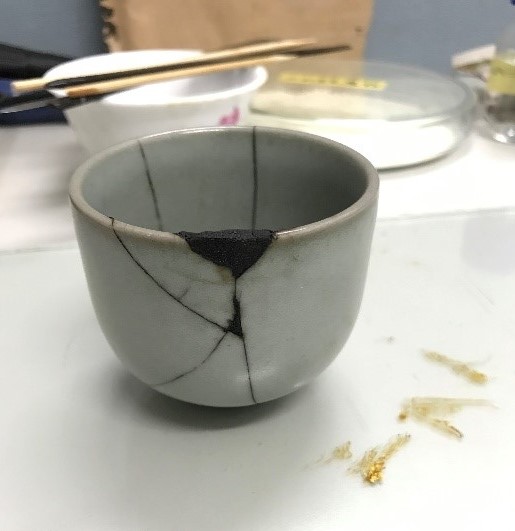
After drying and the broken pieces are stable, mix new clay to fill the gaps. Wait for it to dry.
> Abrading/modifying
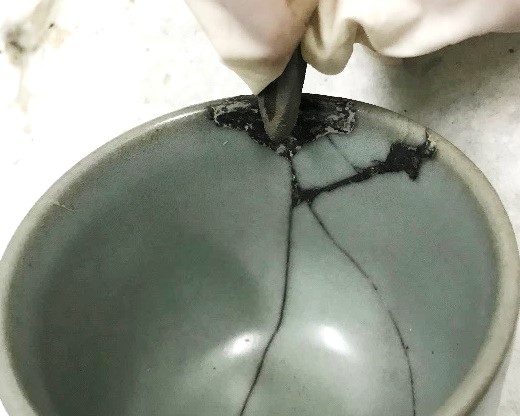
After drying, the newly filled part will harden. If the shape is not suitable or the surface is not smooth, abrade or modify it using sandpaper, a scalpel or a small whetstone.
> Consolidation
Apply a thin layer of urushi (the lacquer) onto the filled parts and cracks, both inside and outside. This operation is for further consolidation of the fillings and adhesion of the edges. Then put the ceramic into a humidity box and wait for it to dry.
> Red paint
Mix the urushi with bengala (a kind of red pigment typically used for decoration on lacquerware, the main element is hematite (Fe2O3)). Apply the mixed red paint lacquer on to the ceramic. You can change or modify the thickness to be slim or broad, according to what kind of patterns you have designed or are needed for the work being undertaken.
These pictures show the colour change after applying red paint. It is necessary to observe the dryness of the paint before undertaking the next step. It is better that it is neither too wet nor too dry, with experience being necessary when making this judgement.
> Applying gold powder
Apply gold powder on the red paint when the paint is half-dried. If the paint is too dry then the powder will not stick on it; on the other hand, if the paint is too wet, the gold powder will sink into the paint and not show as golden lustre.
The left picture was taken just after finishing applying gold powder, displaying a smooth and shiny golden lustre. The right picture shows less lustre and some red paint emerging after drying, meaning that the gold powder was applied too early as the paint was still too wet.
> Consolidation
Apply a thin layer of urushi onto the golden patterns to consolidate the powder and stop it from flaking.
> Finish
Conclusion
This was my first try at Kintsugi and was far from perfect but very interesting. Kintsugi is not a very hard skill to manipulate, but every step is quite delicate and needs much practice to complete expertly. Differently from many modern conceptions of conservation, conservators usually retain any broken parts without too much intervention or hiding of deficiencies. Kintsugi reflects an attitude towards deficiency and giving an old object a new life of beauty. This idea is called “wabi-sabi” in Japanese – the philosophy of the art of imperfection.
- March 2024 (1)
- December 2023 (1)
- November 2023 (2)
- March 2023 (2)
- January 2023 (6)
- November 2022 (1)
- October 2022 (1)
- June 2022 (6)
- January 2022 (8)
- March 2021 (2)
- January 2021 (3)
- June 2020 (1)
- May 2020 (1)
- April 2020 (1)
- March 2020 (4)
- February 2020 (3)
- January 2020 (5)
- November 2019 (1)
- October 2019 (1)
- June 2019 (1)
- April 2019 (2)
- March 2019 (1)
- January 2019 (1)
- August 2018 (2)
- July 2018 (5)
- June 2018 (2)
- May 2018 (3)
- March 2018 (1)
- February 2018 (3)
- January 2018 (1)
- December 2017 (1)
- October 2017 (4)
- September 2017 (1)
- August 2017 (2)
- July 2017 (1)
- June 2017 (3)
- May 2017 (1)
- March 2017 (2)
- February 2017 (1)
- January 2017 (5)
- December 2016 (2)
- November 2016 (2)
- June 2016 (1)
- March 2016 (1)
- December 2015 (1)
- July 2014 (1)
- February 2014 (1)
- January 2014 (4)
